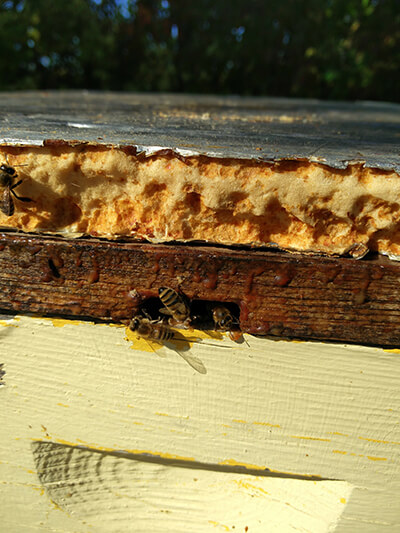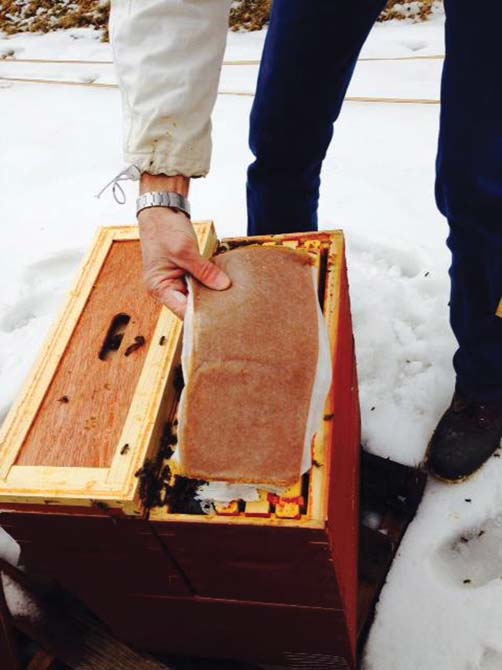If you are a part of a beekeeping club or Facebook group, or if you simply talk to other beekeepers, you’ve probably heard of many different types of hive setups for winter. Some overwinter their bees in one deep, others in two, some in three mediums, and yet others take no honey all year and leave their full-height hive setup. If there is a true “right” way to configure your hive for winter, we have yet to figure it out. The truth of it is that wild honey bees live in large hollowed-out trees, and they make that work just fine. Since all of the beekeeping strategies described above sometimes work, it proves that your bees can survive no matter which strategy you choose. Bees can survive in many different setups. But we as beekeepers want to do whatever we can to increase our colonies’ chances of surviving winter, so how should we choose one of these strategies?
When it comes to the top of your hive, you might wonder whether you need an insulated outer cover, a quilt box, a shim, or any of the other product names you may have heard thrown around. Our advice is to forget about the particular products for a second, and just consider the three topics that matter when you are planning your winter hive top setup: insulation, ventilation, and feeding.
Adding insulation to your hives for winter
In addition to protecting your hives from wind and weather by wrapping them with an insulated hive wrap, you might also consider the benefits of adding insulation to your hive top.
Adding insulation to the top of your hive serves two key purposes: heat retention and moisture control. Since heat rises, honey bee colonies lose the most warmth through their “attic.” Adding insulation to the hive top helps retain some of that heat. Top insulation also reduces the amount of condensation that can drip onto your bees. As bees consume and digest honey, they release water vapor in their breath, which rises to the top of the hive and condenses. This built-up condensation can “rain down” on your bees, and soaking your bees during an already cold time of year can spell disaster. An insulated hive top will keep the ceiling over your bees from becoming cold, so moisture won’t condense there. Because the walls of the hive are colder than an insulated roof, moisture condenses there instead. Safely away from the bees, the moisture rolls down the side of the hive. The bees can drink this excess moisture if they need it, or they can simply leave it alone to drain out the bottom of the hive.
Following are some products you can use to add insulation to your hive. If you have a standard 10 or 8 frame hive with a telescoping outer cover, consider adding a piece of foam board insulation:
- below your outer cover and above your standard or deep rim inner cover
- below your outer cover and above your shim (no inner cover is used with a shim)
You can skip the foam board altogether and go with an insulated telescoping outer cover, which features a 1” piece of R5 insulation built right into the cover. The foam in the cover is fully enclosed, protecting it from bees and ants and ensuring long durability. Yet another option is to use a Bee Smart Insulated Inner Cover, which features a domed inner surface, allowing bees to move freely and creating room for winter patties and other feed. The 2” R10 insulation helps to reduce colony energy demand, which is crucial during the winter months. All of these options help retain heat in the hive and reduce the amount of condensation that could rain down on the bees. And the great news is that, if you forget to remove your insulated hive top setup after winter, it will continue to protect your bees through the hotter months, preventing the sun from beating down on the hive and increasing the inside temperature.
Regardless of which type of hive top insulation you use, it’s always a good idea to use a hive strap to hold your hive setup tightly together. No matter how carefully you plan your insulated hive roofing plan, it won’t do your bees any good if a gust of wind blows it across the bee yard.
How to ventilate your hives
Hive ventilation is another topic about which you can ask 10 beekeepers and get 15 different answers. How much ventilation do your bees need? Should I use a top entrance for airflow, or plug it up? Is a screened bottom board too much ventilation for a cold winter, or not? In our yards, we’ve found some winter top ventilation leads to better results than none.
Because bee hives experience stack effect just like our homes do, without providing a controlled way for warm, moist air to escape, it will build up inside the hive. Adding some form of insulation to your hive top setup can help, but may not completely eliminate moisture build-up on the inner top of the hive, which can then fall on the cluster. Even though bees can survive in an environment with more carbon dioxide and lower oxygen than a human can (read this story of how honey bees survived being buried in volcanic ash) they still need some air exchange to stay healthy.
Introducing an upper entrance can help remove excess moisture and stale air from the hive. It doesn’t have to be a large entrance, just a small opening to allow some air to escape. We use a few different methods to add an upper entrance, and one may be better for you than another, so we recommend experimenting:
- Option 1: Flip the notch down on your standard inner cover or open the ventilation hole in the deep rim inner cover then push your telescoping outer cover forward, leaving a gap for air (and bees) to exit
- Option 2: Use a feeding shim and remove the plug
- Option 3: If you use a Lyson polystyrene hive with Lyson outer cover, you can mix and match the foam and vent plugs to get the ventilation you’d like
Some beekeepers choose to use a quilt box during the winter months to absorb excess moisture from their hives and to provide some top insulation. Read this article to learn how to make your own quilt box using a shallow box, two feeding shims, and a few other materials.
How to feed your bees in winter
Even if one of our colonies starts the cold season with 100+ pounds of honey, odds are pretty good that they will consume it and need supplemental feeding by spring. When the time comes to add that feed, you can be ready by having a feeding shim on hand (or keeping it on the hive and ready), using a deep rim inner cover with the “deep” side facing down, or using a Bee Smart insulated inner cover. These three options allow space for winter patties or your own easy-to-make sugar bricks. Watch this video for more information on winter feeding. It’s important not to feed your bees liquid feed during a cold winter, since the added moisture can easily lead to dysentery if the bees can’t regularly fly out of the hive to relieve themselves.
Final thoughts
Hive insulation and ventilation might look very different in your neck of the woods than it does in ours in the northeastern United States. We hope that this article explained the principles of manipulating the insulation or ventilation of your hive setups in winter and the products that you could use to do so. The decision on “if” and “how” you set up your hive for winter is entirely yours! If you have any questions, we are more than happy to help you talk through your options. Shoot us an email at support@betterbee.com or give us a call at 800-632-3379.


